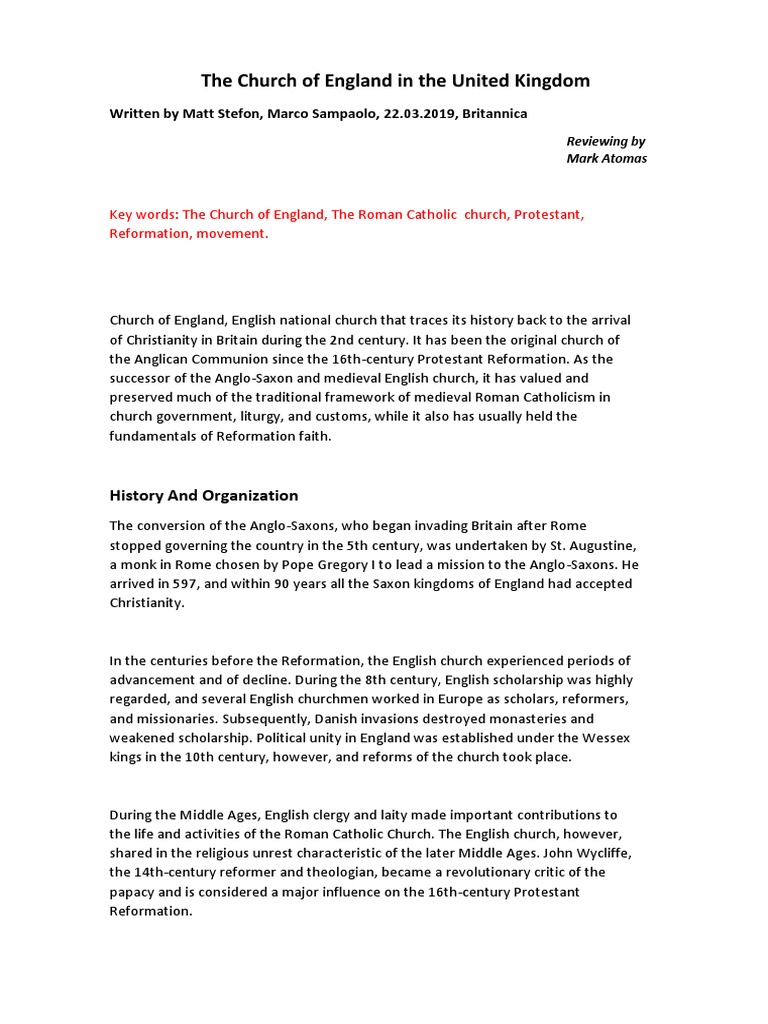In the annals of English history, few figures loom as large as King Henry VIII, whose tumultuous reign in the early 16th century heralded the advent of the Church of England. The establishment of this ecclesiastical body was not merely a haphazard reaction to personal desires; rather, it was an intricate tapestry woven from threads of religious fervor, political machination, and an unquenchable thirst for autonomy. To comprehend the genesis of the Church of England is to traverse a labyrinth of ambition, piety, and rebellion against the ghostly specter of papal authority.
To understand this metamorphosis, one must first acknowledge the historical milieu in which Henry VIII found himself. The dawn of the Reformation was marked by a profound discontent with the Roman Catholic Church, characterized by rampant corruption, the sale of indulgences, and a disconnection between the clergy and the laity. This was a period ripe for transformation, as the seeds of dissent were planted in the fertile ground of theological inquiry and burgeoning nationalism. In this context, Henry VIII emerged not just as a monarch but as a harbinger of change—a potent mix of reformer and despot.
At the heart of Henry’s discontent was his tumultuous marriage to Catherine of Aragon. Despite their years together, the union bore no male heir, prompting Henry to seek a divine answer to his plight—a plea for annulment. However, when Pope Clement VII, ensnared in the political cauldron of Renaissance Italy, refused to sanction the annulment, Henry found himself at a crossroads. Herein lies a profound metaphor: like a ship tethered to a rotting dock, Henry realized that his ambitions could not flourish under the weight of papal authority.
Thus, the seeds of the English Reformation were sewn not merely from the vanities of a spurned king but from a burgeoning sense of national identity. Henry’s desire for a male successor morphed into a broader desire for sovereignty. As the winds swept across the English landscape, stirring the embers of Protestant thought, there was a burgeoning recognition that England need not remain shackled to Rome. The concept of ‘Divine Right of Kings’ took center stage, elevating the monarch to a status akin to that of a sovereign priest. In this light, Henry’s actions can be perceived as a quest for liberation, not only for himself but for the entirety of the English church.
The Act of Supremacy in 1534, which declared Henry as the “Supreme Head of the Church of England,” was a gavel strike marking a new ecclesiastical epoch. With this proclamation, Henry drew a proverbial line in the sand—a deliberate severance from the papal supremacy that had long governed his realm. The Church of England emerged not merely as an offshoot of Catholicism but as a unique entity imbued with its own identity, liturgy, and governance.
However, the creation of the Church of England was not solely the act of a single monarch; it was a collective consequence of myriad influences reverberating through society. The emergence of figures such as Thomas Cranmer, the Archbishop of Canterbury, played a pivotal role as well. Cranmer, a theologian, and reformer, would become instrumental in shaping the doctrine of the nascent Church. His influence illustrated the harmonious interplay of monarchy and emerging theological thought. Like a skilled conductor directing an orchestra, Cranmer blended traditional practices with new reformative doctrines, giving life to a distinctly Anglican symphony.
Moreover, the dissolution of the monasteries between 1536 and 1541 revealed another layer of complexity. Beyond the ecclesiastical reformations, Henry’s maneuvers allowed for a seismic redistribution of wealth and power. Monasteries, once veritable bastions of Catholic influence, were dismantled, the land redistributed, and the coffers of the Crown filled. This act exemplified the collision of spiritual and temporal power; the very act of reform, though perceived as pious, was not devoid of political astuteness.
As the ecclesiastical landscape transformed, so too did the relationship between the Crown and its subjects. The new Church of England, with its liturgies and doctrines, began to resonate with a populace eager for change. The royal supremacy brought forth a unique identity—one that was distinctively English and yet deeply intertwined with the broader currents of Protestant thought sweeping across Europe. It engendered a faith that, while uniquely Anglican, was not devoid of the historical and spiritual richness of its antecedent traditions.
However, the establishment of the Church of England was not without its vicissitudes, as subsequent monarchs oscillated between allegiance and antipathy toward the nascent church. This oscillation underscored the fragility of Henry’s creation and the enduring struggle to define what it meant to be both English and Christian in a landscape fraught with division.
In conclusion, the creation of the Church of England was an intricate narrative woven by King Henry VIII, defined by personal ambition and fueled by nationalistic fervor. The resultant church was not merely a reflection of Henry’s desires but a complex mosaic formed by the interplay of political authority, theological innovation, and societal transformation. As one surveys the reverberations of this historical moment, it becomes clear that the Church of England stands not only as a testament to the transformative power of one Monarch but as a symbol of the enduring quest for identity, autonomy, and faith.



